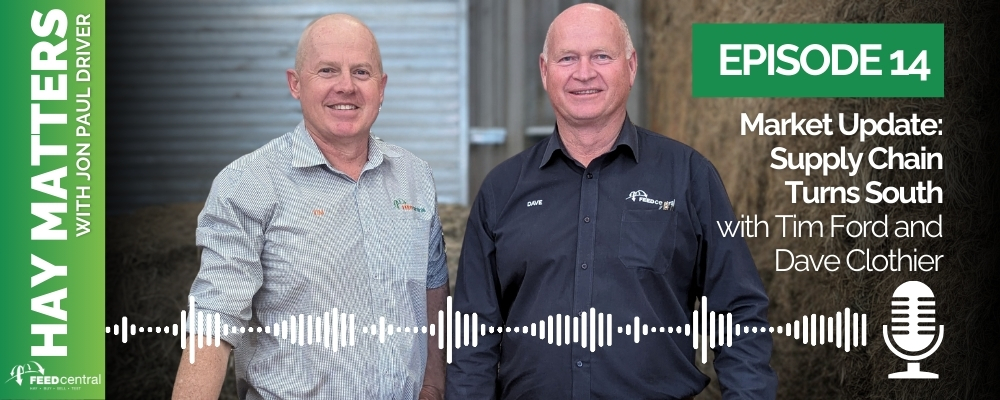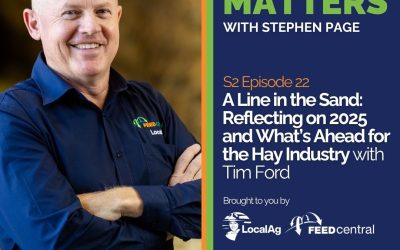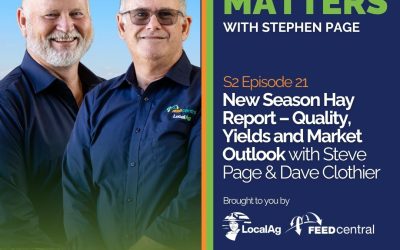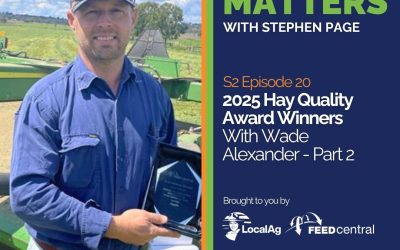
This week, Jon Paul Driver caught up with Tim Ford and Dave Clothier for a special hay market update. They discussed recent weather challenges, including the ‘green drought’ in Southern Victoria and South Australia, and the subsequent feed gaps and high demand for hay. Despite these issues, there have been some positive developments with recent rains aiding re-sowing efforts. They also highlighted the industry’s adaptive strategies, such as the southward movement of hay supplies and the industry’s movement towards maintaining robust supply chains and quality feed testing.
Tim Ford, Director:
- While there has been recent rain, many areas continue to experience a “green drought” with slow grass growth, particularly in the intensive grazing and dairy regions of Southern Victoria and South Australia.
- Despite some growth stimulated by summer rain, a dry autumn and delayed onset of winter have led to significant feed gaps and strong demand for hay, which has shifted industry dynamics.
- Historically, intensive dairy areas produced their own silage; however, this year has seen a substantial southward movement of hay from northern Victoria and Southern New South Wales, disrupting established supply chains.
- Reports indicate a disconnection between hay producers and consumers, possibly due to lost relationships and a general lack of knowledge on how to secure hay supplies, further complicated by changes in business ownership and succession planning.
- Feed Central has been facilitating the procurement of necessary feed since the 2002 drought, focusing on aligning the right product with customer needs through a detailed six-step process including listing, inspection, grading, testing, and delivery coordination.
Dave Clothier, National Sales Manager:
- Lucerne prices are coming down slightly to stimulate the market as we head into the colder months.
- Sheds continue to empty in preparation for the new season, resulting in minimal carryover, which is great for filling with high-quality new season hay.
- Western Victoria and South Australia have been dry, affecting yields and leading to a big feed gap; recent rains are helping, but spring weather will be critical to watch.
- Hay is moving from northern and eastern Victoria into these drier areas, with some growers re-sowing due to delayed rain.
- In Southern Queensland, hay is already on the ground, with conversations happening on early harvests around mid to end of August in northern NSW; longer curing periods will potentially have an impact on quality.
- Stable hay pricing is anticipated, similar to last year, but dependent on factors including above-average rainfall and the potential for frosted crops affecting volumes.
- With a bumper grain harvest forecasted, we might see a softening in hay prices, impacting both the hay and export markets.
Read Transcript
Jon Paul Driver 0:05
Welcome to the Feed Central Hay Matters podcast your go to source for all things hay related in Australia. I’m your host, Jon Paul driver. In today’s episode, we’re joined by Tim Ford, Director for Feed Central. Welcome to the podcast.
Tim Ford 0:19
Thanks, JP. Great to be here.
Jon Paul Driver 0:20
Let’s talk about the gorilla in the room. Drought in Victoria and South Australia.
Tim Ford 0:27
Yeah, it’s interesting. It’s definitely real. There’s been some some rain in recent times, which is wonderful to see in the last couple of weeks in in some areas, I think there’s still plenty of people that have missed out. The reality is it’s just so cold at this time of year that the grass the grass growth is really very slow in that area. So there’s, there’s a lot of catching up to do. They’re calling it a green drought there is a layer of green across the landscape but fundamentally feed is feed is incredibly short through those really intensive grazing and dairy regions of southern Victoria and across through well and truly through South Australia.
Jon Paul Driver 1:06
This might be where there’s just barely enough water but it’s so cold the plants aren’t using the water is I mean, this is what comes to my mind.
Tim Ford 1:14
Yeah, that’s exactly right. I mean it is there you know, there’s significant rainfall deficiencies through those regions. And, a little bit of rain that has fallen through the way you know, the there was some summer rain which produced some growth but then a really dry autumn, a very late and slow start to winter. And it’s no time no time for grass to grow before it’s up before it’s gotten cold. So, you know, that’s created a, you know, really significant feed gap for those people and credit a really strong, really strong demand for high yet sort of turned, turned the industry upside down to a small degree as well.
Jon Paul Driver 1:55
No, say upside down. You’re the one that taught me that, generally speaking, hay, move south to north in Australia. How’s that going to change?
Tim Ford 2:02
Yeah look, generally over the last 10 years or so we’ve seen those intensive dairy areas produce probably a lot of their own silage in they’ve been able to cover a large, large volume of their in feed through self production through production on their own properties. And subsequently, the hay that’s been produced in the really traditional hay regions of northern Victoria, Southern New South Wales has been moving north into New South Wales and into Queensland. But this year, a lot of that hay has has been moving south in fairly significant volumes. And subsequently, a lot of people’s connections have been broken or that, you know, there hasn’t necessarily been the connections between the producers and the consumer of hay. And so there’s been a lot of, I suppose there’s been reports of just disconnection and people not knowing how to buy hay, where to source it from, I don’t think that there’s necessarily a great shortage of hay or there hasn’t been up until now. But there’s been a lack of connections and a lack of knowing where where to go to secure the supply. Because as I said, a lot of those people wouldn’t have bought hay in volumes in recent times. And a lot of the suppliers haven’t haven’t sold into those regions for some time, subsequently, you know, the connections have been lost. And over the years, and you know, with succession planning, and so forth, businesses, change hands, etc, etc. So there’s just been a real disconnection between our buyer and seller. In that time in that part of the world over the over the last couple of winter months, I suppose.
Jon Paul Driver 3:47
No this wouldn’t be the first time that you’ve seen this. In fact, Feed Central has a pretty long history of helping producers facilitate those relationships, those connection points.
Tim Ford 3:59
Yeah, look, we’ve been doing this since since 2002. So we started in that millennial drought, which was all about helping people secure the product that they needed through the millennial drought. You know, in more recently 17-18-19-20 drought was very significant as well. And subsequently, you know, we got a lot a lot of experience in moving product around the country during these challenging times. The real key thing that, you know, our team really just enjoys gets a kick out of helping people secure the product that they need, not necessarily just buy the product, just because it’s available. But you know, I think our team gets a real kick out of buying the product that really helping supply the product that really suits the customer’s need. That’s what we get a real kick out of at Feed Central. That’s what I know the team gets a real kick out of.
Jon Paul Driver 4:49
If somebody’s new to feed central in the system. How does it work?
Tim Ford 4:53
To keep it simple. There’s sort of a six step process that that we go through to get the product up online, and sold. So fundamentally, we’ve got a sales team that are working with buyers and sellers every day of the week. And then we have a web platform where a lot of buyers and sellers will go on the sellers will go on to manage their listings update their listing, buyers will go on to search, very extensive search function that allows them to search for exactly the height that they’re looking for platform allows them to get a delivered price, including freight, and the price or hay, so it’s a very, it’s a very smart system that we’ve been building for a long time. But fundamentally, you know, step one is the listing comes into our office, either online or over the telephone. And then we have a team of inspectors that go out and inspect every line of hay that we list and sell. So our team of inspectors go out, they’re fully trained and certified to be able to inspect hay in our system, and then that allows us to develop a visual grade. So we have a double A B, and C grading system that allows the buyer to see very quickly what the visual quality of that hay is. And that’s to a fairly extensive system that we won’t get into the detail of how that works today, but and then the sample comes back to our office and we get a feed test done. So we got to feed testing lab in the office here. So the sample comes back to the office, we get the feed test done, we put all of that information online. So we have photos, videos of the hay photos of the hay, all the visual description of a hay, extensive visual description of hay, the visual grade, that gives us some reform of the visual quality. And then the feed testing attribute to the hay, all of that information is online and our sales team and our clients will log on and use that information to help find the height that suits our that suits the buyer. So that information is all available 24/7. The ones the deal gets done. And then the team here will organise the freight and facilitate the payment. So you know, we do like to ensure that all the money works absolutely perfectly. Every grower gets paid within payment terms, and so forth. So there’s sort of a six step system that allows us to be able to get that product delivered to to what the buyers want, really allows us to really nail down if you know if someone’s got a milk fat problem, they can search for a particular type of hay with heifers they’ll be looking for something else and work closely with them to get that to get that hay. And that’s what we see. That’s what the system is designed to do. And that’s what we get an enormous amount of personal satisfaction out of when we get that right. Using the system.
Jon Paul Driver 7:39
So what I just heard you say is listing on farm inspection feed test at your own feed Test Lab.
Tim Ford 7:46
Yeah, yeah, so where we have the Dairy One, our calibrations here in Australia, so Dairy One, New York based dairy dairy Co Op, that developed the calibrations for feed testing in the 1960s. And so we use their calibrations here means that we can get a really high quality feed test to international standard are basically overnight once the sample arrives here. So yeah, everything’s feed tested, allows buyers to go on and search by protein requirements, search by energy requirements online, we don’t list or sell anything without that feat test. And without that on farm inspection, it’s really important so so we get it right, and that we don’t have quality complaints. Everyone knows what they’re getting. Yeah, just we know, we’ve had that system going for a long time now. And over the years, it’s some it just helps us get the right product to the right buyer. And that’s incredibly important to us
Jon Paul Driver 8:40
That feeds into the web listings and sales and then your other area of expertise here is the freight and logistics making the logistics happen.
Tim Ford 8:47
Yeah, yeah, the logistics is huge component of it. I think last year, we got some numbers recently, I think last year our trucks are essentially we did enough kilometers and the trucks went to the moon and back and then back to the moon. So in the number of kilometers we did in in carting hay around the country, you know, these days, it’s, you know, some buyers have their own trucks and some sellers have their own trucks. So, you know, the world has certainly changed over the last 510 years with a number of buyers and sellers having their own truck. Once upon a time it was the you know, we were, it was everything was delivered by subcontractors, that, but these days, a lot of buyers and sellers have their own trucks. So it’s a matter of coordinating those schedules and so forth to ensure that the product gets delivered when the buyer wants it. There’s a lot in that, you know, with contracts, making sure the contract delivery happens on time, within contractual terms, making sure that you know, the trucks are you know, a lot of people have a lot of little nuances to make sure that the you know, it’s not delivered on Thursday morning, not just not delivered during milking hours, all of those sorts of things. There’s a whole heap of a whole heap of work in that logistics side of it that the team had to you know, get to do a really good job of and and make it all happen fairly seamlessly.
Jon Paul Driver 10:00
For the folks at Feed Central, you know about the dry conditions in Victoria and South Australia, and you have the capacity to help folks with all the things you just mentioned.
Tim Ford 10:08
Yeah, look, the business that we run certainly has a role in helping people managing drought, flood, fire, it’s all about us rising to the challenge in those times. During those times, you know, we’re endeavoring to do that again, and work with our clients to be able to do that, again, through those really trying times through southern Victoria. In particular, you know, also, you know, the areas of New South Wales, Wollongong and so forth are doing, you know, incredibly wet by the same token, and it’s it is our job to be able to help help those clients as well be able to get feed into those places during those really wet time. So, yeah, look, there is no doubt that the business does need to rise to those challenges drought, frost, fire flood, the business rises to those challenges that we do, you know, we do our very best during those times.
Jon Paul Driver 10:59
Tim, thank you very much for joining us today. Again, I’ve been joined by Tim Ford, Director of Feed Central. It’s always wonderful to have you on, stay tuned in. We’re joined by Dave Clothier, National Sales Manager at Feed Central, welcome back to the podcast.
Dave Clothier 11:14
Thanks JP great that be here again.
Jon Paul Driver 11:17
It’s been a little over a month since we talked have we seen any change in pricing on hay?
Dave Clothier 11:22
I generally speaking, JP, not a lot has changed since we last spoke, the prices are stable. The only one if there’s anything moving lucerne’s probably coming down a fraction just to try and get the market moving as we get into those cold winter months. So that’s the only one come back a wee bit. But as you can imagine, supplies are diminishing in this space before new season. So sheds are continuing to empty, prior to new season, which is great. And it’s all so having an effect on you know, minimal carryover, which is great again, you know, it means we can fill the sheds with quality hay and new sizes.
Jon Paul Driver 11:58
Now there’s some regional differences. We know there’s drought in western Vic and South Australia.
Dave Clothier 12:05
Unfortunately, in the continent, we live in Australia. It’s always somebody’s turn JP. And for the last few months, it’s certainly been Western Vic and South Australia that has been dry, although there has been rainfall throughout much of those areas. Now it’s compromise yields moving forward for reduced production, there’s a big feed gap in there. So there’s still a lot of hay moving from northern and eastern Vic across into those areas. I only heard today from a couple of pretty serious growers in the area that they’re even having to re sow just because of the delay in any rain events. So that’s not good for them. But at least they’re heading in the right direction now with some rainfall. So that’s positive news. Just depending on what the spring does to those guys, I would watch that closely because that have could have some serious impact on volumes out of out of that state. So that’s pretty Western Vic is very similar to those areas. If you move into central and eastern Victoria sorry and southern New South Wales, generally speaking, they look very good. Although they will be Western vehicle be later similar to South Australia, eastern central and southern New South Wales will be earlier, as we’ll be in, we can just talk about North event northern New South Wales, Southern Queensland. There’s hay on the ground as we speak right now in southern Queensland. And there’s lots and lots of conversation about hay hitting the ground towards the middle of the end of August, which is which is obviously earlier. And there are some risks with that. So these are some of the things that I think we should be watching for, you know, with the hay production through the cooler months, it could be very much some challenges through the curing process with that becomes the risk of rain events, bleaching, grade degradation, all those sorts of things. And the forecast for much of New South Wales in southern Queensland is above average rainfall through to the end of October so that there are some challenges ahead of those areas. There’s no doubt about that. So there’s some real things to watch for me before we start understanding what the market is going to look like and what the prices will be. At the moment, it feels like the pricing is going to be very similar to last year. But some things I think we need to watch out for is one is that above average rain forecasts like what volume of FCA grade hay versus a lower grade or hay through New South Wales and southern Queensland through those earlier productions that could have an effect on price than the notes curing. The challenges associated with that the potential for frosted crops, you know, we’re right in the middle of winter now we could have some reasonable volumes, which will help supply depending on what we’ve got in front of us for summer, there’s a bumper grain harvest forecast right through the Grainbelt. Now, traditionally, when we’ve got to bumper grain harvests, there’s a softening in prices, whether we will have an effect on that through the hay production and hay prices, we’ll just have to wait and see. And the other one that’s a little bit unknown to is just the needs of the export industry. If we’ve got larger volumes coming into Southeast coming from South Australia and Western Victoria, they have to get to source it further north, we’ll just have to wait and see, and what effect that will have on supply and price. These are the things I think we just need to watch, because there is no clear direction in any of those things at the moment, just back on the demand front just quickly, like, you know, there are some winter feed gaps as we’re treated traditionally see this time of year through the east to the Great Dividing Range a little over the West, but mainly east to the Great Dividing Range. Our website or platform continues to be very, very strong. And that’s through those drier, Western Viq. And South Australian areas, although it’s trickling outside of there as well. And with the feedlot industry, which is a large part of our business, there’s some uptake, just to fill that gap until new season happening across some areas, but a lot of them still have enough volume to keep them going through that space.
Jon Paul Driver 16:42
All right. Is there anything we missed?
Dave Clothier 16:45
The only other thing we could say is you know, Feed Central we’ve got a team of eight people down here at Coffs Harbour, which is on the north coast in New South Wales for the Australian Fodder Industry Association Conference, which you joined us at last year JP, we look forward to many discussions with some of the largest growers in the industry and trying to understand the challenges that they see and trying to help the industry. Right across the board.
Jon Paul Driver 17:14
Dave, as usual, it’s wonderful to have your thoughts.
Dave Clothier 17:18
Thanks very much, JP great to have another yarn.
Jon Paul Driver 17:21
The podcast is proudly presented by Feed Central stay tuned in for upcoming episodes.



